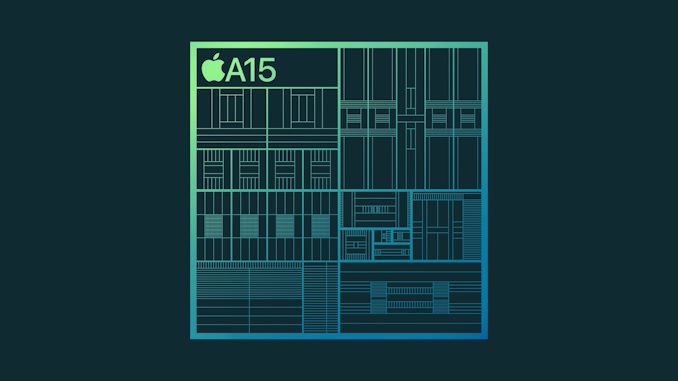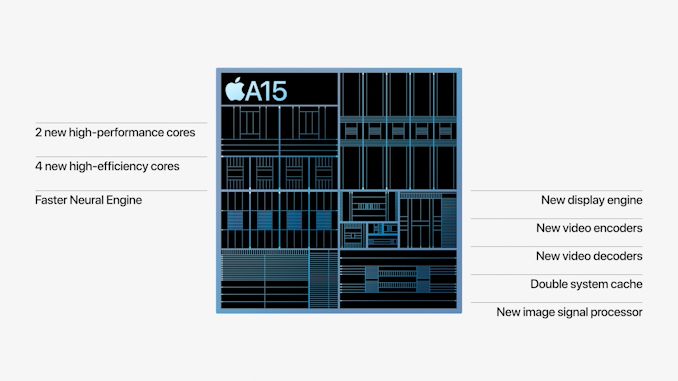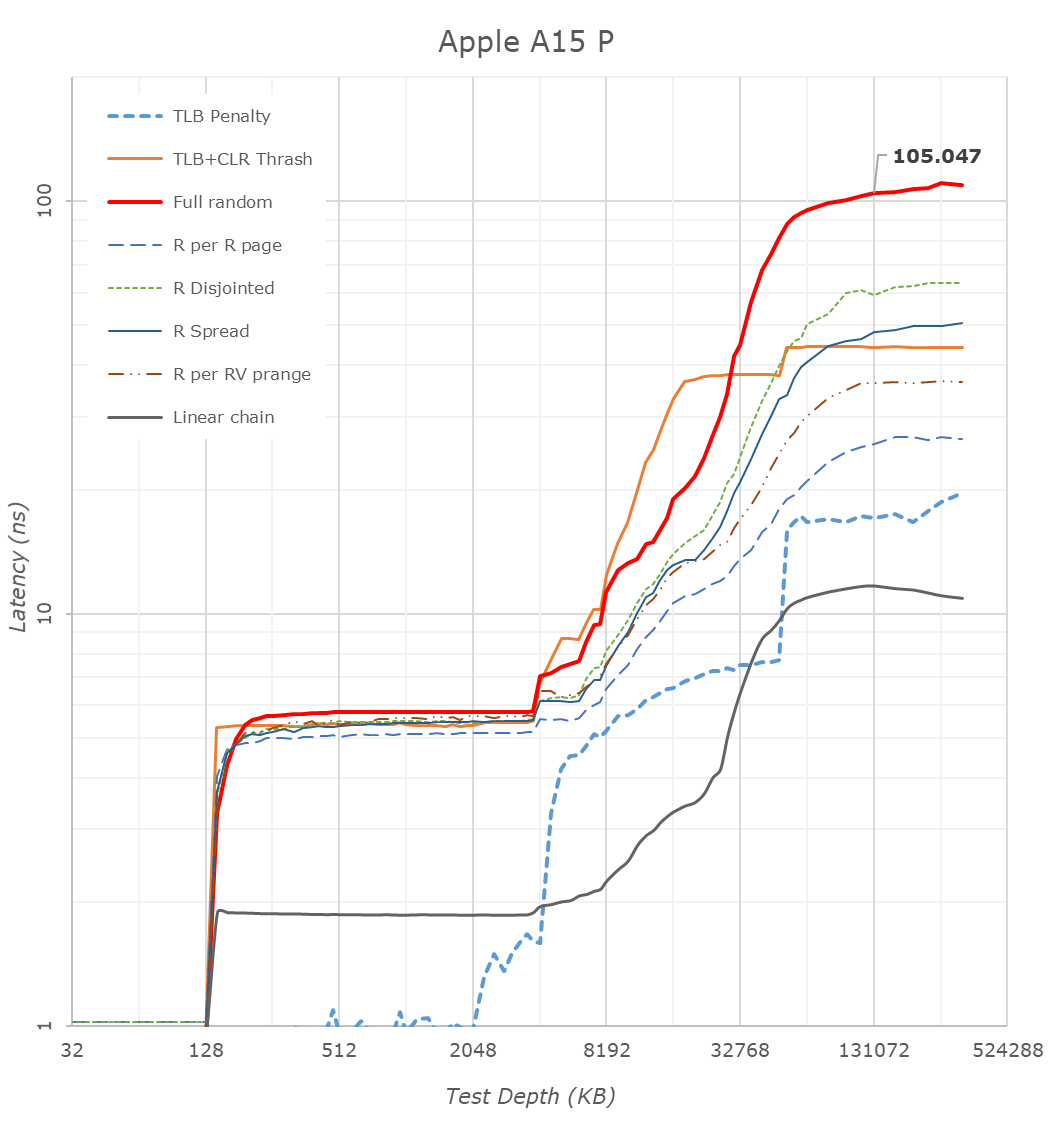The Apple A15 SoC Performance Review: Faster & More Efficient
by Andrei Frumusanu on October 4, 2021 9:30 AM EST- Posted in
- Mobile
- Apple
- Smartphones
- Apple A15

A few weeks ago, we’ve seen Apple announce their newest iPhone 13 series devices, a set of phones being powered by the newest Apple A15 SoC. Today, in advance of the full device review which we’ll cover in the near future, we’re taking a closer look at the new generation chipset, looking at what exactly Apple has changed in the new silicon, and whether it lives up to the hype.
This year’s announcement of the A15 was a bit odder on Apple’s PR side of things, notably because the company generally avoided making any generational comparisons between the new design to Apple’s own A14. Particularly notable was the fact that Apple preferred to describe the SoC in context of the competition; while that’s not unusual on the Mac side of things, it was something that this year stood out more than usual for the iPhone announcement.
The few concrete factoids about the A15 were that Apple is using new designs for their CPUs, a faster Neural engine, a new 4- or 5-core GPU depending on the iPhone variant, and a whole new display pipeline and media hardware block for video encoding and decoding, alongside new ISP improvements for camera quality advancements.
On the CPU side of things, improvements were very vague in that Apple quoted to be 50% faster than the competition, and the GPU performance metrics were also made in such a manner, describing the 4-core GPU A15 being +30% faster than the competition, and the 5-core variant being +50% faster. We’ve put the SoC through its initial paces, and in today’s article we’ll be focusing on the exact performance and efficiency metrics of the new chip.
Frequency Boosts; 3.24GHz Performance & 2.0GHz Efficiency Cores
Starting off with the CPU side of things, the new A15 is said to feature two new CPU microarchitectures, both for the performance cores as well as the efficiency cores. The first few reports about the performance of the new cores were focused around the frequencies, which we can now confirm in our measurements:
| Maximum Frequency vs Loaded Threads Per-Core Maximum MHz |
||||||
| Apple A15 | 1 | 2 | 3 | 4 | ||
| Performance 1 | 3240 | 3180 | ||||
| Performance 2 | 3180 | |||||
| Efficiency 1 | 2016 | 2016 | 2016 | 2016 | ||
| Efficiency 2 | 2016 | 2016 | 2016 | |||
| Efficiency 3 | 2016 | 2016 | ||||
| Efficiency 4 | 2016 | |||||
| Maximum Frequency vs Loaded Threads Per-Core Maximum MHz |
||||||
| Apple A14 | 1 | 2 | 3 | 4 | ||
| Performance 1 | 2998 | 2890 | ||||
| Performance 2 | 2890 | |||||
| Efficiency 1 | 1823 | 1823 | 1823 | 1823 | ||
| Efficiency 2 | 1823 | 1823 | 1823 | |||
| Efficiency 3 | 1823 | 1823 | ||||
| Efficiency 4 | 1823 | |||||
Compared to the A14, the new A15 increases the peak single-core frequency of the two-performance core cluster by 8%, now reaching up to 3240MHz compared to the 2998MHz of the previous generation. When both performance cores are active, their operating frequency actually goes up by 10%, both now running at an aggressive 3180MHz compared to the previous generation’s 2890MHz.
In general, Apple’s frequency increases here are quite aggressive given the fact that it’s quite hard to push this performance aspect of a design, especially when we’re not expecting major performance gains on the part of the new process node. The A15 should be made on an N5P node variant from TSMC, although neither company really discloses the exact details of the design. TSMC claims a +5% frequency increase over N5, so for Apple to have gone further beyond this would have indicated an increase in power consumption, something to keep in mind of when we dive deeper into the power characteristics of the CPUs.
The E-cores of the A15 are now able to clock up to 2016MHz, a 10.5% increase over the A14’s cores. The frequency here is independent of the performance cores, as in the number of threads in the cluster doesn’t affect the other cluster, or vice-versa. Apple has done some more interesting changes to the little cores this generation, which we’ll come to in a bit.
Giant Caches: Performance CPU L2 to 12MB, SLC to Massive 32MB
One more straightforward technical detail Apple revealed during its launch was that the A15 now features double the system cache compared to the A14. Two years ago we had detailed the A13’s new SLC which had grown from 8MB in the A12 to 16MB, a size that was also kept constant in the A14 generation. Apple claiming they’ve doubled this would consequently mean it’s 32MB now in the A15.
Looking at our latency tests on the new A15, we can indeed now confirm that the SLC has now doubled up to 32MB, further pushing the memory depth to reach DRAM. Apple’s SLC is likely to be a key factor in the power efficiency of the chip, being able to keep memory accesses on the same silicon rather than going out to slower, and more power inefficient DRAM. We’ve seen these types of last-level caches being employed by more SoC vendors, but at 32MB, the new A15 dwarfs the competition’s implementations, such as the 3MB SLC on the Snapdragon 888 or the estimated 6-8MB SLC on the Exynos 2100.
What Apple didn’t divulge, is also changes to the L2 cache of the performance cores, which has now grown by 50% from 8MB to 12MB. This was actually the same L2 size as on the Apple M1, only this time around it’s serving only two performance cores rather than four. The access latency appears to have risen from 16 cycles on the A14 to 18 cycles on the A15.
A 12MB L2 is again humongous, over double compared to the combined L3+L2 (4+1+3x0.5 = 6.5MB) of other designs such as the Snapdragon 888. It very much appears Apple has invested a lot of SRAM into this year’s SoC generation.
The efficiency cores this year don’t seem to have changed their cache sizes, remaining at 64KB L1D’s and 4MB shared L2’s, however we see Apple has increased the L2 TLB to 2048 entries, now covering up to 32MB, likely to facilitate better SLC access latencies. Interestingly, Apple this year now allows the efficiency cores to have faster DRAM access, with latencies now at around 130ns versus the +215ns on the A14, again something to keep in mind of in the next performance section of the article.
CPU Microarchitecture Changes: A Slow(er) Year?
This year’s CPU microarchitectures were a bit of a wildcard. Earlier this year, Arm had announced the new Armv9 ISA, predominantly defined by the new SVE2 SIMD instruction set, as well as the company’s new Cortex series CPU IP which employs the new architecture. Back in 2013, Apple was notorious for being the first on the market with an Armv8 CPU, the first 64-bit capable mobile design. Given that context, I had generally expected this year’s generation to introduce v9 as well, but however that doesn’t seem to be the case for the A15.
Microarchitecturally, the new performance cores on the A15 doesn’t seem to differ much from last year’s designs. I haven’t invested the time yet to look at every nook and cranny of the design, but at least the back-end of the processor is identical in throughput and latencies compared to the A14 performance cores.
The efficiency cores have had more changes, alongside some of the memory subsystem TLB changes, the new E-core now gains an extra integer ALU, bringing the total up to 4, up from the previous 3. The core for some time no longer could be called “little” by any means, and it seems to have grown even more this year, again, something we’ll showcase in the performance section.
The possible reason for Apple’s more moderate micro-architectural changes this year might be a storm of a few factors – Apple had notably lost their lead architect on the big performance cores, as well as parts of the design teams, to Nuvia back in 2019 (later acquired by Qualcomm earlier this year). The shift towards Armv9 might also imply some more work done on the design, and the pandemic situation might also have contributed to some non-ideal execution. We’ll have to examine next year’s A16 to really determine if Apple’s design cadence has slowed down, or whether this was merely just a slippage, or simply a lull before a much larger change in the next microarchitecture.
Of course, the tone here paints rather conservative improvement of the A15’s CPUs, which when looking at performance and efficiency, are anything but that.












204 Comments
View All Comments
Nicon0s - Tuesday, October 5, 2021 - link
... modemLiverpoolFC5903 - Tuesday, October 5, 2021 - link
I understand that an apple SOC will probably cost 2-3 times at least considering the points you mentioned, but will it be a deterrent for OEMs? High end smartphones from the likes of Samsung and Sony are north of 1200 gbp, so they are pretty expensive anyway. Would a couple hundred quid added to the BOM and passed on the customer dent the overall sales of these top end smartphones? A customer who is paying 1400 gbp for the latest Note phone will probably be ok paying 1700 for a phone thats almost twice as fast. I personally would be happy to pay such prices for a high end droid with an A15 or even A14 soc , more so than paying that amount for a Z flip or something.Imagine the immense potential of such a device. One can dream.
To summarise, i dont believe cost will be a deterrent for OEMs, especially as customers are clearly willing to pay for cutting edge tech, as indicated by steady smartphone sales year on year despite a steep increase in prices of premium phones over the last 10 years.
michael2k - Wednesday, October 6, 2021 - link
I don't see how you could be close to correct.Worldwide Apple has 15% marketshare; lets pretend that of the remaining 85%, another 15% really would pay the extra an OEM would charge for the performance Apple offers.
In other words, a good chunk of Samsung's user base (since they have 18% globally) would be willing to pay a premium for iPhone level performance, even if it's a one year old SoC instead of the current year SoC.
The iPhone 11 Pro Max was estimated to have a $64 SoC; if Apple is to profit from selling it let us assume they charge $50, so that Apple sells each chip for $114:
https://www.techinsights.com/blog/apple-iphone-11-...
Qualcomm theoretically charges Samsung $57:
https://www.gsmarena.com/samsung_galaxy_note20_ult...
So if that means they can sell 200m chips at $114 and a $50 profit, they get $10b in profit a year and $22b in revenue from chip sales. That's healthy, and relevant since their 2020 revenue was $274b!
However, if they only got $5 per chip, their profit would only grow $1b and their revenue only by $2.2b, so clearly it wouldn't make sense to sell their chips for only $70. The question then is do you really think they could sell 220 million chips a year for $114?
And don't forget that this isn't going to be free for them, since they have to provide the drivers and basic supporting hardware for OEMs to use (essentially a reference design).
To compare to their other revenue streams, their smallest revenue stream right now is the iPad at roughly $30b a year:
https://www.apple.com/newsroom/pdfs/FY21_Q3_Consol...
So you have to expect Apple to aim for something comparable if they were to sell SoC (hence my original assumption of $50 profit per chip)
Speedfriend - Thursday, October 7, 2021 - link
For what most people use a phone for, the difference in speed is unnoticeable. I have had both an iPhone and Android as daily phones for at least 5 years and never felt one was noticeably faster than the otherNicon0s - Thursday, October 7, 2021 - link
>The question then is do you really think they could sell 220 million chips a year for $114?Impossible. The couldn't even get 200 million chips to sell.
Also in order to have a pure 50$ in profits the price for the SOC would have to be bigger than 114$. Apple also has to offer support for these chips, drivers and so on. Those are additional costs, some of them long term.
Ppietra - Thursday, October 7, 2021 - link
Nicon0s,Apple already "produces" around 250 million chips for itself, most of them usually at the most recent node process, leaving vacant most of the older production capacity... So it would be possible for Apple to produce extra 100-200 million older chips if it wanted to.
Nicon0s - Sunday, October 10, 2021 - link
You are missing a few important details. It takes apple 1 year or more to get their hands on over 200 million chips. It would be hard to double the production output at any given time in order to sell chips to other companies. Also the older production capacity is never vacant and it's always booked in advance.Also Apple wouldn't be able to sell an A13 at such a premium vs the latest Android SOCs. Maybe the SD898, exynos 2200 or dimensity 2000 won't be top in performance but they will sure offer better performance than an A13 SOC so I was obviously talking about the A15 in my comment.
Ppietra - Sunday, October 10, 2021 - link
don’t see what I am missing!the 200 million you commented about already represented 1 year production, that means what would be produced would be dispersed throughout the year.
Changing business models doesn’t happen overnight, so no one was talking about Apple selling 200 million by next year specifically. No one here was assuming nor can say that Apple would change things with no pre-established plan... that would be absolute nonsense.
What people are talking about is Apple establishing a business where it would sell 200 million a year and reap profits from it - it’s an hypothetical.
But I could put it in another perspective if Apple were planning to sell old SoCs by next year then it would already have planned its contracts to produce more.
Nicon0s - Saturday, October 16, 2021 - link
At least follow the conversion if you want to join in. He was specifically talking about selling 200 million chips to other companies and I specifically answered to that. The quote and my answer are in the same place.Also the 200 million is obviously in addition to Apple's own chips which they use for their products.
>But I could put it in another perspective if Apple were planning to sell old SoCs by next year then it would already have planned its contracts to produce more.
Even if it did volume would be much lower as most of the capacity will already be booked and those chips would still be quite expensive and obviously less competitive. The only way apple could get more is if they outbid. Realistically TSMC would not simply turn their back ro their other costumer just to only sell to Apple.
Ppietra - Saturday, October 16, 2021 - link
Nicon0s, It’s Apple that is already using that near 200 million manufacturing capacity. Once a new year comes it will be adding more manufacturing capacity with a new node... so no, there is no problem with volume, if it planned for it, Apple would be able to have those contracts because it would already be in the position where it was using that capacity. Apple already outbid others to be the first using it.